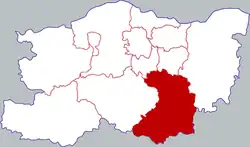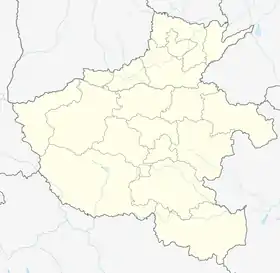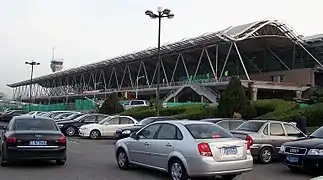Xinzheng
新郑市 Sincheng | |
|---|---|
 Pagoda in Xinzheng with Soviet architecture in the background | |
 Location in Zhengzhou | |
 Xinzheng Location in Henan | |
| Coordinates (Xinzheng municipal government): 34°23′47″N 113°44′25″E / 34.3964°N 113.7402°E | |
| Country | People's Republic of China |
| Province | Henan |
| Prefecture-level city | Zhengzhou |
| Area | |
| • Total | 873 km2 (337 sq mi) |
| Elevation | 114 m (374 ft) |
| Population (2019)[1] | |
| • Total | 989,900 |
| • Density | 1,100/km2 (2,900/sq mi) |
| Time zone | UTC+8 (China Standard) |
| Postal code | 451100 |
| Website | www |
Xinzheng (simplified Chinese: 新郑; traditional Chinese: 新鄭; pinyin: Xīnzhèng) is a county-level city of Henan Province, China. It is under the administration of the prefecture-level city of Zhengzhou, the provincial capital. The city has a population of 600,000 people and covers an area of 873 square kilometres (337 sq mi), 15 km2 (5.8 sq mi) of which is urban.[2]
History
Xinzheng is considered one of the birthplaces of the Chinese nation. More than 8000 years ago, neolithic people of Peiligang culture lived in the vicinity. The legendary Yellow Emperor was said to have been born in Xinzheng 5000 years ago. During the Zhou dynasty it was the capital of the state of Zheng and later, the state of Han, after the conquest of the former by the latter. It was the seat of government for the Qin dynasty, from about 221 BCE, which is considered the beginning of a unified China. The word qin (秦), which is pronounced similar to "chin", is thought to be the basis for the word "China."
Historically, this prefecture was an integrated part of Zhengzhou. However, in 1994, the Henan Provincial Council authorized the incorporation of Xinzheng into a separate municipality.[3]
Administrative divisions
As 2012, this city is divided to three subdistricts, nine towns and three townships.[4]
- Subdistricts
|
|
- Towns
|
|
- Townships
|
|
Climate
| Climate data for Xinzheng (2004–2020 normals, extremes 1981–2010) | |||||||||||||
|---|---|---|---|---|---|---|---|---|---|---|---|---|---|
| Month | Jan | Feb | Mar | Apr | May | Jun | Jul | Aug | Sep | Oct | Nov | Dec | Year |
| Record high °C (°F) | 21.0 (69.8) |
24.2 (75.6) |
27.7 (81.9) |
35.5 (95.9) |
38.5 (101.3) |
39.7 (103.5) |
41.0 (105.8) |
38.5 (101.3) |
38.6 (101.5) |
36.8 (98.2) |
28.1 (82.6) |
23.9 (75.0) |
41.0 (105.8) |
| Mean daily maximum °C (°F) | 5.8 (42.4) |
9.2 (48.6) |
16.0 (60.8) |
22.0 (71.6) |
27.7 (81.9) |
32.0 (89.6) |
31.9 (89.4) |
30.6 (87.1) |
26.7 (80.1) |
21.8 (71.2) |
14.5 (58.1) |
8.2 (46.8) |
20.5 (69.0) |
| Daily mean °C (°F) | 0.6 (33.1) |
3.8 (38.8) |
10.2 (50.4) |
16.1 (61.0) |
21.9 (71.4) |
26.3 (79.3) |
27.3 (81.1) |
26.0 (78.8) |
21.4 (70.5) |
16.0 (60.8) |
9.0 (48.2) |
2.8 (37.0) |
15.1 (59.2) |
| Mean daily minimum °C (°F) | −3.3 (26.1) |
−0.4 (31.3) |
5.2 (41.4) |
10.7 (51.3) |
16.3 (61.3) |
21.0 (69.8) |
23.5 (74.3) |
22.5 (72.5) |
17.3 (63.1) |
11.6 (52.9) |
4.7 (40.5) |
−1.3 (29.7) |
10.7 (51.2) |
| Record low °C (°F) | −14.8 (5.4) |
−17.9 (−0.2) |
−6.2 (20.8) |
−1.3 (29.7) |
4.9 (40.8) |
10.4 (50.7) |
17.0 (62.6) |
12.5 (54.5) |
6.3 (43.3) |
−0.5 (31.1) |
−10.4 (13.3) |
−13.6 (7.5) |
−17.9 (−0.2) |
| Average precipitation mm (inches) | 11.0 (0.43) |
13.7 (0.54) |
23.3 (0.92) |
38.0 (1.50) |
57.7 (2.27) |
74.4 (2.93) |
148.3 (5.84) |
121 (4.8) |
78.3 (3.08) |
44.0 (1.73) |
30.8 (1.21) |
9.5 (0.37) |
650 (25.62) |
| Average precipitation days (≥ 0.1 mm) | 3.9 | 4.2 | 5.3 | 5.9 | 6.9 | 7.5 | 11.4 | 10.3 | 8.7 | 6.1 | 5.4 | 3.5 | 79.1 |
| Average snowy days | 4.0 | 3.2 | 1.1 | 0.2 | 0 | 0 | 0 | 0 | 0 | 0 | 1.2 | 2.8 | 12.5 |
| Average relative humidity (%) | 60 | 60 | 60 | 62 | 62 | 62 | 76 | 78 | 74 | 67 | 66 | 61 | 66 |
| Mean monthly sunshine hours | 118.5 | 127.5 | 167.1 | 193.7 | 208.5 | 194.7 | 172.7 | 171.5 | 150.2 | 151.2 | 138.7 | 132.0 | 1,926.3 |
| Percent possible sunshine | 38 | 41 | 45 | 49 | 48 | 45 | 40 | 42 | 41 | 44 | 45 | 43 | 43 |
| Source: China Meteorological Administration[5][6] | |||||||||||||
Education
Xinzheng has one of the largest concentrations of foreign teachers in central China due to the presence of Sias International University. The school has over 27,000 students and over 120 foreign teachers and their 40 dependent family members. Along with Sias University, the city is also home to another university: ShengDa.[7][8]
Economy
Xinzheng has a diversified economy, though agriculture and heavy industry dominate the economic landscape.
Agriculture
Xinzheng's agriculture involves the cultivation of maize, cotton, tobacco and other industrial crops. The city is well known for its jujube or Chinese Date. At harvest time, large quantities of these fruits are sold in markets, as well as on the side of the roads into the town.[9]
Industry
Xinzheng is home to several industrial factories, namely cigarette factories, which are located near the center of town. In 2006, more than US$2 billion was invested in a nearby industrial project,[10] although the status of this investment is currently unknown. Mining coal locally has also been an important source of income.
Impact of educational institutions
Two large private universities, ShengDa University and Sias International University play a major role in the local economy as well. ShengDa has 14,000 students,[7] and Sias University has over 27,000 students.[8] Service industries (restaurants, hotels, banks, retail shops, etc.) to accommodate the students have sprung out around the universities in abundance. At Sias, the administration tacitly allows students to live off campus, creating a large community of landlords around the university. The presence of 40,000 students has had an undeniable and long lasting impact on the community.
Tourism

Due to limited accommodation, lack of infrastructure, pollution and other factors, tourism has been slow to take off in Xinzheng. Every Spring, the city hosts a ceremony honoring the Yellow Emperor, the legendary ancestor of the Chinese nation. In 2009, this celebration attracted over 10,000 Chinese people from within the People's Republic of China, as well as many Overseas Chinese.[11]
However, many of these guests find accommodations in nearby Zhengzhou, and the economic impact to the city is minimal. Xinzheng is said to be an 'open-air' museum, and the nearby Shizu mountain is said to be the exact birthplace of the Yellow Emperor. The Zhengzhou Dragon realization company began construction at the turn of the 21st century of a large concrete dragon that would straddle the mountain.[12]
A giant dragon was being constructed by private investors near the city out of concrete and marble with a 29.9m tall head and a body that would have stretched 21 km (13 mi) along the ridge line of Shizu Mountain.[13][14] The hollow body of the dragon was slated to be 9m high and 6m wide and would have contained a light rail system along with facilities for sight seeing and leisure, such as shops, restaurants and luxury clubs.[14] The project was expected to be completed before October 1, 2009, to celebrate the 60th anniversary of the founding of the People's Republic of China.[13][15] However, lack of funding, and a general lack of interest, left the project unfinished.
Transportation
Air
The airport that serves the provincial capital, Zhengzhou Xinzheng International Airport (IATA: CGO, ICAO: ZHCC), is located in Xinzheng. This is of particular importance not only because it is an airport for a large urban center, but because it is the only international airport for the province of 100 million.[16][17] On February 8, 2009, a nonstop air route between Zhengzhou and Taipei–Taoyuan was launched; this route was initially operated by Shenzhen Airlines.[18]
Rail
As in the rest of China, rail transport in Xinzheng is handled by the China Railway Corporation. Xinzheng itself had a small railroad station, Xinzheng railway station, at the edge of town that used to accommodate trains on the Beijing–Guangzhou railway, as well as to and from Zhengzhou. It is no longer open.[19]
However, nearby Zhengzhou is a major railway hub, with services radiating in all directions nationally. As of 2007, high-speed rail service began between Zhengzhou and Beijing.[20] To do any travel beyond the Zhengzhou immediate area, most residents travel to Zhengzhou, then onward.
Mass transit
The regional bus station to the north of the town's city center (34°26′12″N 113°45′21″E / 34.436638°N 113.755725°E) serves buses destined for Zhengzhou, Xinmi, Kaifeng, and Luoyang.[21]
Taxi
All Xinzheng taxis belong to the same local company, with a starting fare of 6 renminbi.
Roads
Xinzheng is well connected to Zhengzhou and points south by China National Highway 107. All inter-city roads are well maintained. Within the city limits, as in the rest of many small Chinese cities, many residential roads remain in a serious state of disrepair.
Image gallery
 Construction of the Dragon on Shizu Mountain in Xinzheng
Construction of the Dragon on Shizu Mountain in Xinzheng Entrance into West Xinzheng
Entrance into West Xinzheng
References
- 1 2 最新人口信息 www.hongheiku.com (in Chinese). hongheiku. Retrieved 2021-01-12.
- ↑ "Xinzheng introduction". China Council for the Promotion of International Trade. Archived from the original on September 27, 2007. Retrieved 2018-10-27.
- ↑ Xinzheng Municipal Government Archived June 14, 2008, at the Wayback Machine
- ↑ 洛阳市-行政区划网 www.xzqh.org (in Chinese). XZQH. Retrieved 2012-05-24.
- ↑ 中国气象数据网 – WeatherBk Data (in Simplified Chinese). China Meteorological Administration. Retrieved 12 August 2023.
- ↑ 中国气象数据网 (in Simplified Chinese). China Meteorological Administration. Retrieved 12 August 2023.
- 1 2 Shengda Foreign Affairs Office Archived January 16, 2009, at the Wayback Machine
- 1 2 SIAS Website
- ↑ Xinzheng Municipal Government- Economy. Archived June 14, 2008, at the Wayback Machine
- ↑ Life of Guangzhou- China U.S. Industrial Park Project in Henan
- ↑ Beijing Review- Cultural Industry in Henan
- ↑ The Standard- Battle for the Dragon's Lair Archived September 7, 2009, at the Wayback Machine
- 1 2 "Construction of giant dragon in C. China drives debate". Xinhua. March 27, 2007. Retrieved March 28, 2007.
- 1 2 "Dragon 'to rival Great Wall of China'". Ananova. March 27, 2007. Retrieved March 28, 2007.
- ↑ "Giant dragon to recline on Henan mountaintop". Shanghai Daily. March 27, 2007. Retrieved March 28, 2007.
- ↑ World Aero Data- CGO [usurped]
- ↑ Henan Provincial Government (Chinese)
- ↑ "Direct air route launched between Henan and Taiwan" GOV.cn Archived February 2, 2012, at the Wayback Machine February 9, 2009
- ↑ Chinese Railway System website(Chinese)
- ↑ Zhengzhou Railway Bureau(Chinese) Archived February 11, 2009, at the Wayback Machine
- ↑ 新郑长途汽车站_新郑长途汽车时刻表. cncn.com (in Simplified Chinese). Retrieved 2018-10-27.

